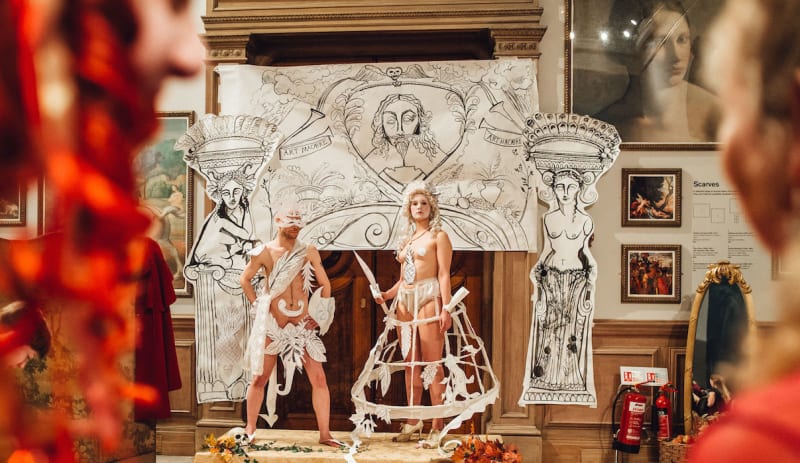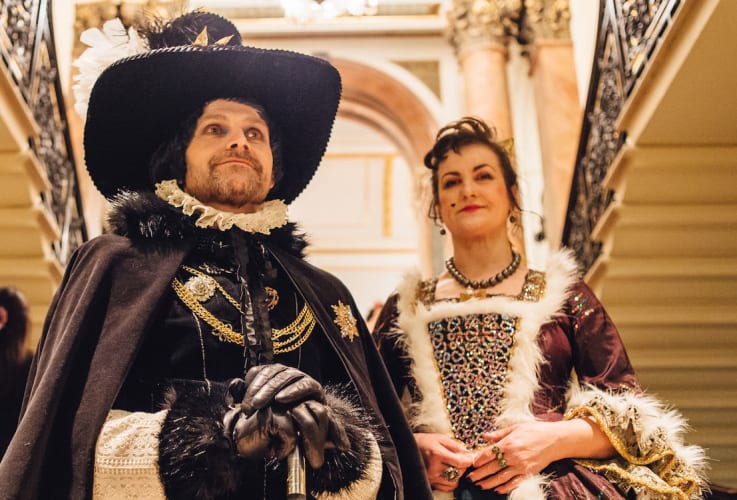The Royal Academy was founded in 1768 and is celebrating its 250th anniversary. As part of its festivities for this RA Late opening, it took its theme from the current exhibition Charles I: King and Collector which, for the first time since the 17th century, reassembles surviving works of art from his royal collection.
For one evening, those attending were to imagine themselves taken back to 1640 and Burlington House transformed into Whitehall Palace where the entertainments on offer included a performance of a Court Masque: The Celestial Triumph, “a tale of malignant spirits who threaten to disturb the King’s peaceful rule.”
The promise of something “inspired by the extravagant performances for the king and his circle” and “the glittering and lavish sets of architect and masque designer Inigo Jones” was irresistible.
On arrival, the “Palace” was already buzzing, baroque music playing in the grand entrance hall as guests arrived, many in full period costume or other glittering fineries, feathered and floral head-dresses or token ruffs.
Up the grand staircase, there was access to the sequence of rooms where the king’s collection is on display and taking a more discrete stair to go higher there was entrance to the Privy Lodgings, the king’s own apartments and it was here, at the end of a sequence of private rooms, not as one might expect in the Great Hall, that the masque was staged.
But first a surprise: King Charles himself greeting each guest as they arrive, his Chamberlain making the introduction, though the name and background he mentions may be a 17th century invention. In the royal rooms, there was refreshment available (exotic if anachronous cocktails) and the programme suggested the chance to learn performance skills, even audition, though I saw no sign of that but among the numerous other courtiers was granted a few words with Queen Henrietta Maria.
The performance space proved a disappointment: a thrust stage of carpet backed by a simple proscenium and edged by benches with thrones for Their Majesties behind them. In fact, when Charles and Henrietta Maria had taken their places and the show could begin, there was a hiatus.
This was a one-off, so I don’t have to worry about spoilers. Wilson and Hart’s production avoids any attempt to emulate an opulent court masque. First, no musician (in the singular) has turned up; someone has to be recruited (supposedly) from the audience. Then there is no poet-narrator, not any other performer. The Lord Chamberlain and a couple of hastily rounded-up others have to improvise a performance of this ten-minute tale of the king defeating an evil magician who threatens the kingdom.
It’s a bit of a cop-out: but most of the audience are just here for a good time and thoroughly enjoy it. It’s The Masque that Goes Wrong in miniature (which it has to be or how could the whole sequence be repeated each hour on the hour through the evening?).
Inigo Jones’s masque designs did make an appearance in the Great Hall where Art Macabre’s Paper Theatre offered a life drawing class. Here the models may have started naked but they were gradually garbed in cut-out paper garlands and garment features that guests created after Jones’s drawings. Flesh seemed turned into classical statues and then more additions partially clothed them.
Elsewhere, though much less effectively, people could make their own ruffs from coloured tissue paper and, in what the evening called Revelling Rooms, they could join in the dancing. I am very uncertain what was danced in the Carolean court in the decades that followed the Volta and before the minuet arrived in the 1660s but there might be a courante, a sarabande or a gigue. The Ceilidh Liberation Front were there to provide music and instruction and dances were soon circling with touching palm and skipping down between lines of their fellows in a country dance that might have taken place at the more frenzied end of the evening.
The evening was certainly one of participation with the most immersive experience a performance in what was described as the Whispering Room conducted by Natalie Wildgoose. Here, participants were invited into a leaf-decked bower where they were given a slip suggesting a sound or a phrase (like an “ooo” or a “la-la-la”) to sing when, all having closed their eyes, they were touched. With a musician and Natalie’s voice to start with, each added their sound in a beautiful experience that made even the worst voice part of the harmony.
There was more. In the Banqueting Room, where full meals were available, an historian spoke at various times through the evening about the problems His Majesty was facing. Everywhere, fellow guests added to the spectacle. Nothing however could compare with the exhibition to which all the rest was periphery.
Statues, bronzes, drawings, documents, sketchbooks and miniatures presented the king and his court and the artworks he and his courtiers set store by and a gathering together of paintings that had once been the royal collection. The curators even identify where they hung in the original palace, those that were sold off by the Commonwealth and often who bought them—and of course where they usually hang now. They include many great paintings by old masters, from Raphael and Titian to Rubens and Rembrandt, Van Dyke and Hilliard.
Well worth a visit though the experience was given an even livelier context by the rest of the evening.

